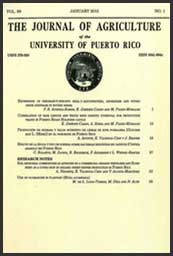Resumen
Hyparrhenia rufa (Nees) Stapf., conocida comúnmente como pasto jaragüa, faragüa o yaragüa, es una maleza agresiva que ha invadido terrenos cultivables en Puerto Rico. Para disminuir la aplicación de herbicidas, se ha propuesto el uso de hongos fitopatógenos para su control. Se identificaron cuatro aislados de hongos asociados a lesiones foliares de H. rufa: Curvularia sp., Fusarium sp., Phoma sorghina y Sphaeropsis sp. Se evaluó su patogenicidad en condiciones de laboratorio, invernadero y campo. Todas las especies de hongos fueron patogénicas al tejido foliar (con herida) en condiciones de laboratorio mientras que P. sorghina y Sphaeropsis sp. fueron las especies más virulentas en el ensayo de invernadero. Fusarium sp. fue la especie más virulenta en el ensayo de campo. Se observaron bajos niveles de infección (nivel 1) en el campo para todos los aislados de hongos evaluados. La severidad de la enfermedad fue estimada en un 25% del área de la parcela experimental. Para completar los postulados de Koch, todos los hongos inoculados fueron re-aislados en agar de papa y dextrosa luego de concluir las pruebas de patogenicidad conducidas en condiciones de laboratorio, invernadero y campo. Este es el primer reporte de Curvularia sp., Fusarium sp., P. sorghina and Sphaeropsis sp. como patógenos foliares de H. rufa.Descargas
Los datos de descargas todavía no están disponibles.

